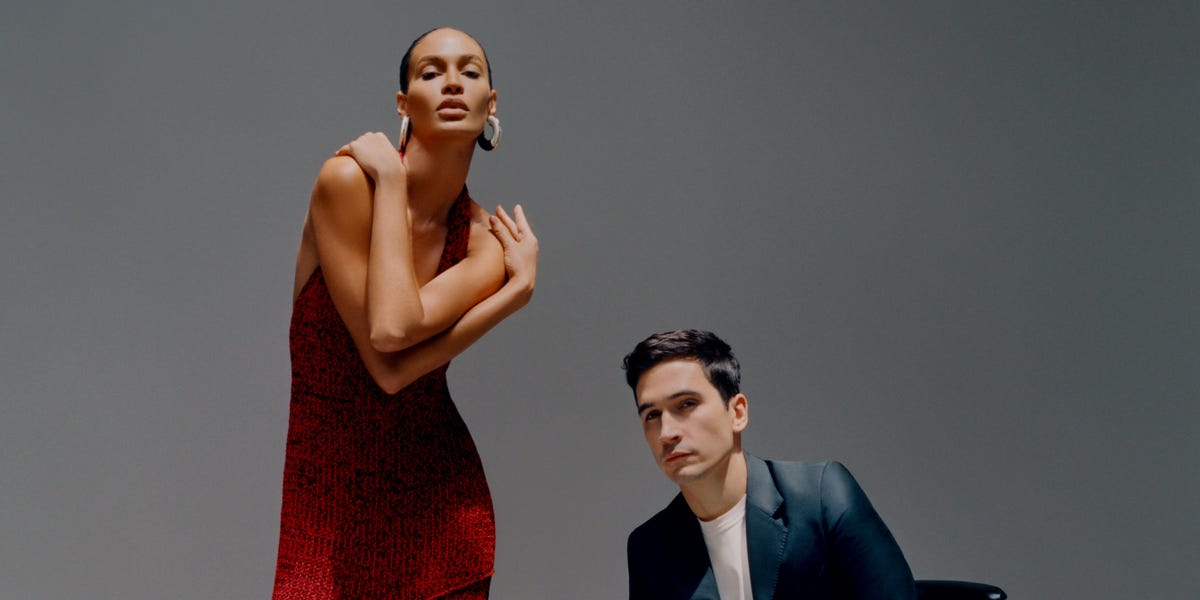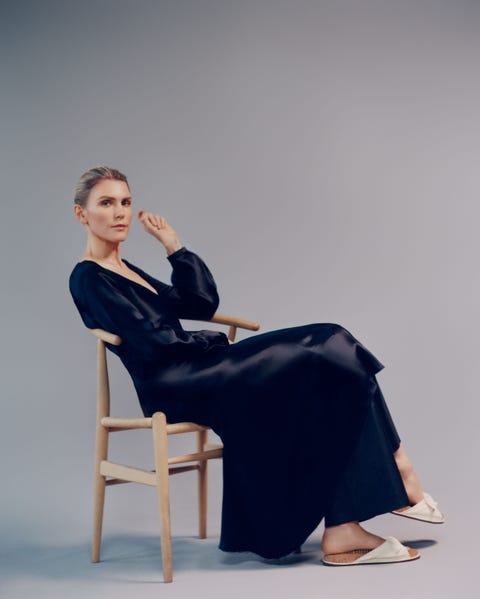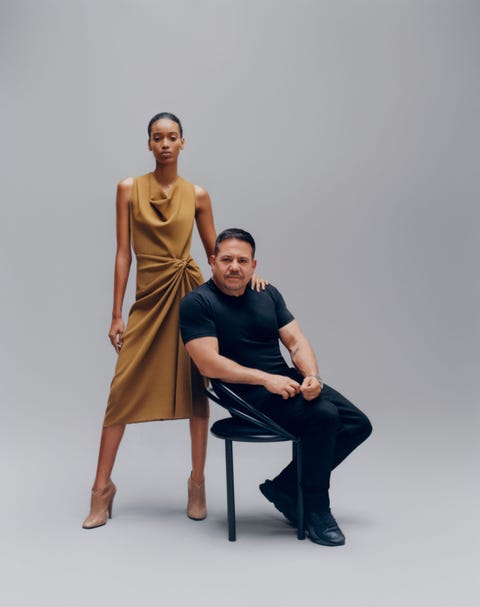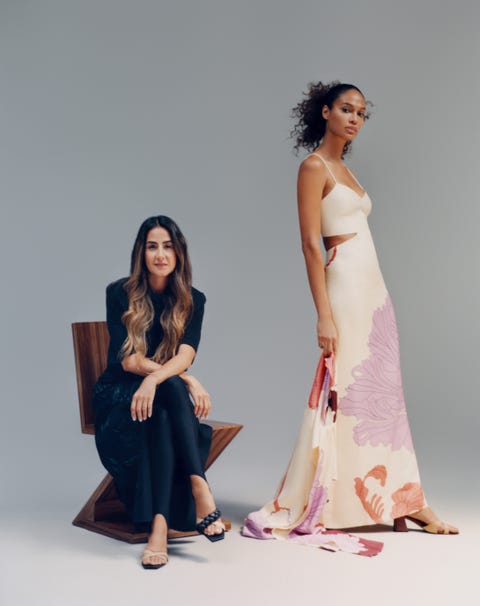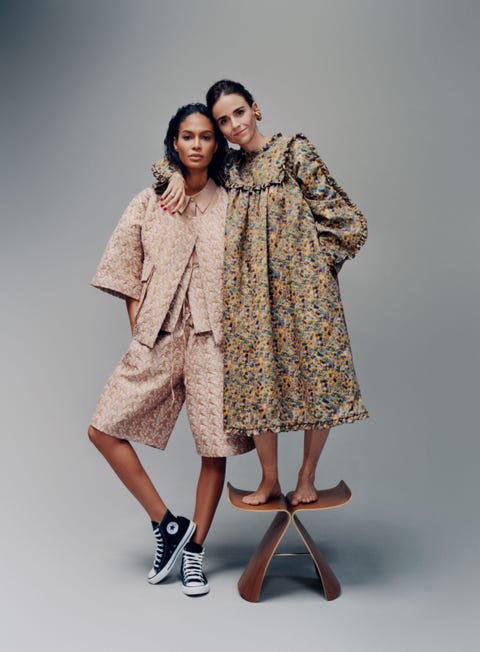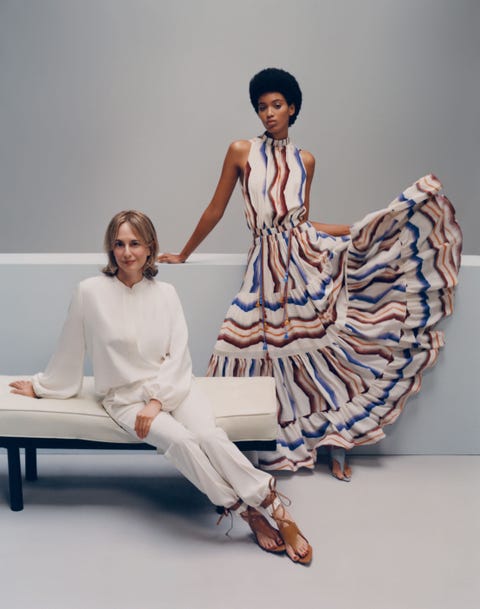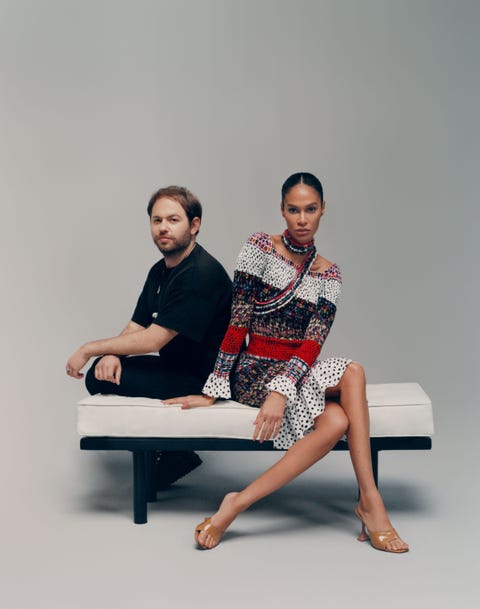How do you speak about a pan-Latin community of fashion designers that spans continents and cultures, from Latin America to the United States? With an awareness of nuance—and an overwhelming sense of joy, pride, and celebration of journeys hard won.
Pioneers such as Adolfo, Oscar de la Renta, and Carolina Herrera— from Cuba, the Dominican Republic, and Venezuela, respectively—distinguished themselves at a time when a Eurocentric vision of beauty was still the norm in this country. They helped reimagine the idea of what American fashion could look like, putting the female form front and center in their work. Today, the current crop of Latin designers brings fresh perspectives, tells personal stories, and champions social issues. Despite varying aesthetics and cultural standpoints, what they share is authenticity—and a commitment to diversity, sustainability, and community empowerment.
GABRIELA HEARST
“I always like the saying that you can take the girl out of the country, but not the country out of the girl,” says Uruguayan-born designer Gabriela Hearst. Her heritage is “so much part of who I am and how I deem what is important or not and my value system. It is everything.” She and her fellow Latinx designers “always have a way of expressing our culture that resonates in a very beautiful way in fashion. I would say we bring some attitude.” Now at the helm of Chloé as well as her namesake brand, the CFDA member cites Carolina Herrera and Oscar de la Renta as early inspirations, and she is doing her part to mentor those coming up behind her by offering “whatever I can share: my experience, my mistakes, what has worked, my point of view,” she says. “I am of service, especially for the up-and-coming designers, because the world is theirs.”
While Latin American designers mostly refer to themselves by their country of origin, some Americans of Latin American descent have more recently embraced the inclusive term Latinx, a gender-neutral alternative. “The issues that Latinx people face are slightly different from those of Latin American people. There’s always an undercurrent of discrimination when we’re talking about minorities in the United States. If you are categorized as a Latino, an Asian American, or a Black person, that has implications in your day-to-day life,” says Tanya Meléndez-Escalante, senior curator of education and public programs at the Museum at FIT, who is currently working with FIT collections and education assistant Michelle McVicker on a Latinx fashion exhibition, slated for 2023.
LAZARO HERNANDEZ
Growing up in Miami, Lazaro Hernandez, who is Cuban American, got an after-school education hanging out at his mom’s beauty salon. “In Cuban culture,” he explains, “women run the show.” He would eavesdrop on the salon’s patrons talking about beauty and fashion. “It was my exposure to the world of women,” he says. “That’s how I got into fashion, via my mom.” When he and Jack McCollough started Proenza Schouler after meeting at Parsons, he found Oscar de la Renta to be a generous mentor. “In the early days, when we had no money, he would find us jobs on the side,” he remembers. “We connected about food and moms; we had similar stories from our culture in common.” He also provided mentorship in a less direct sense: the fact that people like De la Renta and Cristóbal Balenciaga, who “reached the heights of fashion, happen to speak my language. I was like, ‘Oh, I’m just like them.’ I never considered this a space that wasn’t for me.”
As Bogotá-born, Milan- and Chicago-trained Kika Vargas, who was recently named the first Colombian finalist for the prestigious LVMH Prize, says, “Latin heritage is something we carry in our hearts, our system, our DNA. It doesn’t necessarily mean you have to live in Latin America. My Latin heritage is more about feeling powerful.”
Ruben Toledo, the renowned Cuban American artist and fashion illustrator, says, “Diversity itself is the thread that connects, not divides us. We are very aware we come in all skin colors, shades, shapes, and sizes. We applauded diversity from day one.” Like her husband, the late Isabel Toledo made embracing differences her signature. A “designer’s designer,” she left her indelible mark by upholding fashion as art, inspiring the industry and her clients alike with her technical mastery.
NARCISO RODRIGUEZ
While still a Parsons undergrad, Narciso Rodriguez, whose signature sharply-cut minimalism has since drawn devotees from Michelle Obama to Rachel Weisz, was lucky enough to have fellow Latinx designer Oscar de la Renta as a mentor. That relationship touched off a lifelong conversation. “He recognized that I really loved women and celebrated women, and [said] to never lose sight of that,” says the Cuban American designer and CFDA member, who grew up in Newark, New Jersey. “That’s the part of my work that I see most that comes from my heritage, from my upbringing—being raised around all these curvaceous women who really loved fashion and the joy of dressing. [That] made a huge impact on me.”
Celebrating femininity in all its forms, Latin designers have an understanding of the plurality of shapes. Their body-conscious approach does not necessarily mean tight-fitting clothes, but an acceptance of a natural sensuality that allows movement and fluidity. As Toledo explains, “ ‘Body language’ in Latin culture is considered a form of intelligence— knowing how to use your body to its best advantage to help express your
“Emotion is all over Latin American design,” says Cloclo Echavarria, cofounder of Sí Collective, whose mission is to cultivate Latin brands for the international market. “There’s a sense of warmth, a love for color, a sense of the joy of life, the alegría de la vida. It’s a message of hope,” adds Bogotá-born, Miami-trained, and Paris-based Esteban Cortázar. “There is a sense of wanting to show our culture, our artisans, our nature, our beauty. It comes from the heart.”
MARIA CORNEJO
Born in Chile, Maria Cornejo fled to Peru with her parents at 12, following the country’s 1973 coup d’etat. Stints in the UK, France, Japan, China, and Italy followed before Cornejo landed in New York and founded her label, Zero + Maria Cornejo, in 1998. Despite all her worldly references, the designer and CFDA board member credits her birth country with instilling in her the sense of minimalism that has won her a sophisticated, serious clientele. Indigenous people from Chile and Argentina “wear simple black garments with silver jewelry,” she says of one source of her inspiration. “It’s also embedded in the culture. My mother had dresses made for us from leftover fabrics, and we were taught to look after our clothes. Super consumerism is not really our way.”
Sustainability is another central theme. “Latin designers see themselves as entrepreneurs in their countries,” Echavarria says of the talents she works with. “If they are so involved with the community, it is often because the governments and national infrastructures are insufficient.” Committed to responsible design, Chilean-born Maria Cornejo calls New York home and produces about 85 percent of her collection there. But, she adds, “I make sure that every year, I do something with Bolivian or Chilean artisan weavers. Authenticity is really important, and I also want to support my local community in New York and in the Latin space.”
Many Latin designers think locally and prioritize fair wages, ethical sourcing, and personal empowerment. “Latin American fashion is an invitation to celebrate life. It is part of a survival mechanism,” notes fashion management consultant Fabián Hirose. “Good social practices are embedded.”
By nurturing homegrown artisans, Latin designers actively participate in the development of their communities. Using their voice to bring about change in a local capacity is viewed as a personal duty. Cali-based Nancy González, whose local factory employs several hundred workers, says, “Since I started designing accessories in 1998 and working with artisans, I was able to see firsthand the profound transformation their work has on their lives. We have always given priority to female heads of the family— with whom I identify, because when I started working, I was recently divorced with two young children. As the artisans learn and develop their skills, they transmit their empowerment, their pride in providing support and a better future to their families. One of the most important pillars of our organization has become the empowerment of women. It is one of the greatest satisfactions of my work.”
JOHANNA ORTIZ
“I wake up every morning in the tropics, surrounded by plants,” says Cali-based Johanna Ortiz. “It’s made me very conscious of the natural beauty that surrounds me, not only as a source of inspiration but as something to be cherished and protected.” The designer and CFDA member made it a point to return home to start her business after completing her studies at the Art Institute of Fort Lauderdale, employing local seamstresses and artisans whose unique talents inspired her to found La Escuela Johanna Ortiz in 2017. The school provides 340 hours of sewing instruction, as well as classes in subjects from finance to emotional intelligence, for women in Cali. Some of them go on to work for Ortiz, and many choose to found their own businesses—meaning that we’ll likely see many more Johanna Ortizes in the nation’s future.
In the past decade, talents from Colombia, such as Johanna Ortiz and Miami-based Silvia Tcherassi, and from Uruguay, such as New York–based Gabriela Hearst (now the creative director of Chloé, in addition to overseeing her eponymous line), have achieved international acclaim. But there are still few educational institutions in the region fo- cusing on fashion, which makes it harder for aspiring designers to make the needed industry connections. To help address that gap, Mexican and Nicaraguan entrepreneurs Samantha Tams and Estefanía Lacayo cofounded the Latin American Fashion Summit three years ago. “Latin designers use a trial-and-error approach,” Lacayo says. “It was really important for us to provide them with a networking outlet as well as key strategies to implement in their businesses.” Tam adds, “We think it’s a great opportunity for them right now.”
Through their work, Latin designers are emerging to tell the story of a people, their integrity, and their values. Fashion, for them, isn’t just a form of self-expression: It’s a powerful tool to amplify their message of dignity, pride, and optimism.
KIKA VARGAS
As the first-ever Colombian designer to be a finalist for the prestigious LVMH Prize, Bogotá native Kika Vargas is hyperaware of the significance of that mantle. “We don’t usually get these opportunities,” she says. “It’s hard coming from Latin America. It can sometimes feel like you’re far away from the fashion industry’s core.” But in the success of fellow Colombian designers (and friends) Johanna Ortiz and Silvia Tcherassi, Vargas found a blueprint for her own career. Now she divides her time between Colombia, Spain, and the U.S., and finds that the mix of cultures feeds her creativity. Her community of designers, she says, has “our craftsmanship and what we have in our heart and soul that we bring to America, but it is still part of the conversation with American history.” She’s also paying it forward, sharing advice on a WhatsApp chat comprising 100 fellow Latinx designers, discussing everything from sourcing buttons to emotional support. Its title? “La costura nos une” (“The seam unites us”).
SILVIA TCHERASSI
“Barranquilla was the door to Latin America for so many immigrants,” says Silvia Tcherassi of her Colombian hometown, and the rich tapestry of influences that has made its way into her designs. Known for her hand- painted prints and love of volume, Tcherassi opened her first U.S. boutique in Miami’s Coconut Grove 22 years ago, and nine more stores have since joined the roster. “In true Latin fashion,” she says, her family is involved in the business, with daughter Sofia working on the design side and son Mauricio overseeing new business development, including online and wholesale accounts. “It’s very important for me to support Colombia and Colombian talent,” particularly artisans in the Wayuu community, says the designer, whose production is done largely in the country.
JONATHAN COHEN
“My whole family is from Mexico City, but I was born and raised in San Diego,” says Jonathan Cohen. “So we traveled back and forth quite a bit, but as a child you’re not so aware of your influences; they’re just your surroundings.” Looking back now, the New York–based talent, whose designs were worn by First Lady Jill Biden during the 2021 pre-inauguration festivities, can trace his vibrant sense of color to his travels in Mexico—and his wearable designs to Southern California’s laid-back vibe. “Now I embrace the cultural differences,” he says. A prime example: a shirtwaist dress with an American flag–like motif from Cohen’s spring 2020 collection that features rainbow stripes embroidered by female artisans in Mexico City.
This article appears in the September 2021 issue of ELLE.
HEARST: HAIR BY BEN SKERVIN FOR ORIBE; MAKEUP BY NATALIA MEJIA AT BRYAN BANTRY AGENCY NYC; REMAINING IMAGES: HAIR BY GONN KINOSHITA AT THE WALL GROUP; MAKEUP BY KEITA MOORE AT THE ONLY AGENCY; MANICURES BY MICHINA KOIDE FOR DIOR VERNIS; CASTING BY DAVID CHEN; MODELS: JOAN SMALLS AT IMG AND MANUELA SANCHEZ AT DNA MODELS; SET DESIGN BY JAVIER IRIGOYEN AT LALALAND ARTISTS; PRODUCED BY MAY LIN LE GOFF AT ROSCO PRODUCTIONS.
This content is created and maintained by a third party, and imported onto this page to help users provide their email addresses. You may be able to find more information about this and similar content at piano.io
